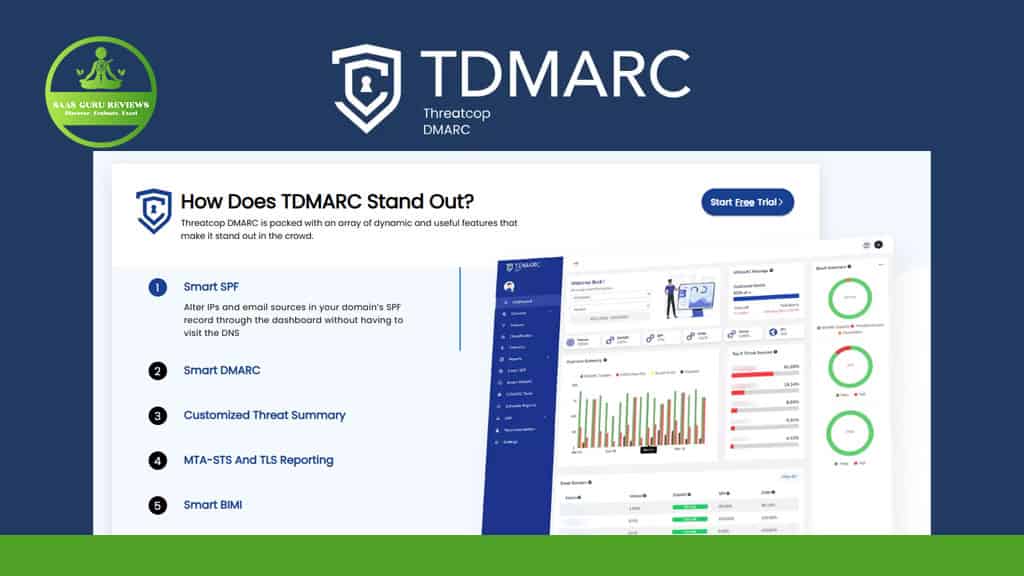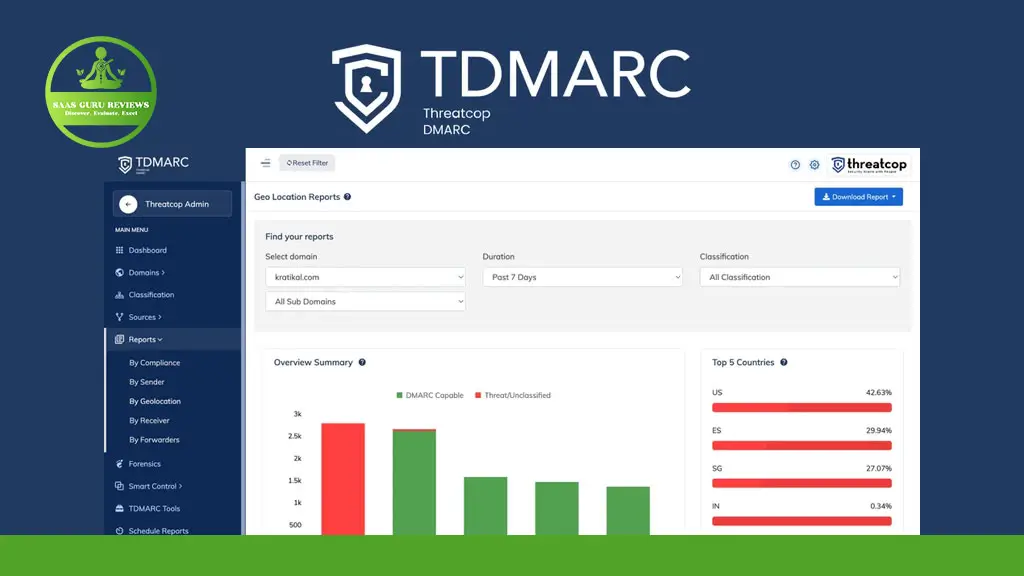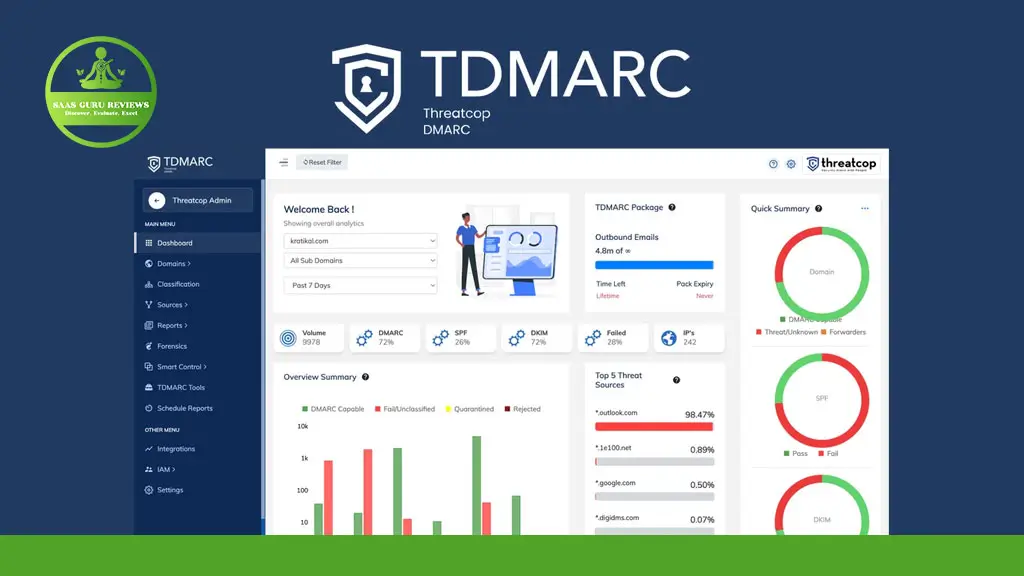In today’s digital landscape, email security has become a critical concern for businesses of all sizes. TDMARC offers a comprehensive solution designed to protect your email domains from spoofing and phishing attacks. With a stellar rating of 4.8 stars from 100 reviewers, TDMARC has established itself as a trusted name in email domain security. This article explores how TDMARC helps organizations implement DMARC protocols effectively, preventing business email compromise (BEC) attacks and securing communication channels. Whether you’re new to email authentication or looking to enhance your existing security measures, this guide will provide valuable insights into how TDMARC can strengthen your cybersecurity posture.
What is TDMARC and How Does It Protect Your Email Domains?
TDMARC is an email authentication solution developed by ThreatCop that helps organizations secure their email domains against spoofing attacks. Founded by Pavan Kushwaha, TDMARC has quickly gained recognition for its robust email security features. The platform enables businesses to implement and monitor DMARC (Domain-based Message Authentication, Reporting, and Conformance) protocols effectively.
With TDMARC, organizations can instantly identify all email sources from a domain, verify legitimate senders, and block malicious actors attempting to impersonate their brand. The solution provides comprehensive visibility into email authentication records like DMARC, SPF (Sender Policy Framework), and DKIM (DomainKeys Identified Mail), allowing businesses to maintain control over their email infrastructure.
According to recent data from SEO analysis tools, TDMARC’s website attracts approximately 13.31K monthly visitors, indicating strong market interest in their email domain security solutions. The domain itself is a premium acquisition, reflecting the company’s commitment to establishing a strong online presence. For the latest updates on TDMARC’s features and capabilities, you can visit their official website at https://tdmarc.com.
Understanding DMARC and Its Importance in Email Security
DMARC serves as a critical protocol in modern email authentication and anti-spoofing strategies. It works alongside SPF and DKIM to verify that incoming emails genuinely originate from the claimed domain. In 2025, as email-based threats continue to evolve, implementing DMARC has become essential for organizations seeking to safeguard their communication channels.
TDMARC simplifies the complex process of DMARC implementation by providing a centralized dashboard where administrators can monitor compliance across multiple domains. The platform automatically identifies misconfigurations in email authentication records and suggests remediation steps, ensuring that your domain’s security posture remains robust against emerging threats.
By leveraging TDMARC’s capabilities, businesses can not only prevent spoofing attacks but also improve sender reputation and email deliverability. This dual benefit makes DMARC implementation through TDMARC a strategic investment for organizations concerned about both security and communication efficiency. The platform’s user-friendly interface makes it accessible even to teams without specialized cybersecurity expertise, democratizing access to advanced email security measures.
How TDMARC Prevents Business Email Compromise (BEC) Attacks
Business Email Compromise represents one of the most financially damaging cyber threats facing organizations today. These sophisticated attacks often involve impersonation of trusted executives or partners to trick employees into transferring funds or revealing sensitive information. TDMARC offers a robust defense against such attacks by ensuring that only authorized senders can use your domain in email communications.
The platform’s anti-spoofing capabilities enable it to detect and block attempts at CEO fraud, false invoices, and other common BEC tactics. By implementing TDMARC, organizations create a security barrier that prevents hackers from successfully impersonating internal stakeholders or trusted external partners. The solution’s real-time monitoring capabilities ensure that any suspicious activity is flagged immediately, allowing security teams to respond before damage occurs.
TDMARC reviews consistently highlight the platform’s effectiveness in mitigating BEC risks. With support available around the clock, organizations can rely on TDMARC’s expertise to navigate complex email security challenges. The platform’s ability to analyze sender information, including IP and country geolocation data, provides valuable context for identifying potential threat sources before they can execute their malicious plans.
ThreatCop’s Comprehensive Email Security Ecosystem
TDMARC is part of ThreatCop’s broader cybersecurity ecosystem, which offers integrated solutions for protecting digital assets. This integration allows organizations to implement a layered approach to security, addressing vulnerabilities across multiple channels. ThreatCop’s YouTube account (https://youtube.com/threatcop) features educational content on email security best practices, providing additional resources for security teams.
The ThreatCop platform complements TDMARC by offering additional security management tools that extend protection beyond email domains. This comprehensive approach ensures that organizations can address the full spectrum of cyber threats, from phishing attacks to more sophisticated compromise attempts. By leveraging ThreatCop’s expertise, businesses can develop a more cohesive security strategy that accounts for the interconnected nature of modern digital threats.
TDMARC’s integration with the broader ThreatCop ecosystem enables seamless information sharing between different security components, enhancing threat detection capabilities. This unified approach to cybersecurity helps organizations maintain consistent protection across their digital footprint, reducing the risk of overlooking potential vulnerabilities in their defense posture.

Key Features of TDMARC for Effective Email Domain Protection
TDMARC offers a range of features specifically designed to enhance email domain security. The platform provides comprehensive visibility into all email sources from a domain, allowing administrators to identify unauthorized senders quickly. This capability is crucial for organizations with complex email infrastructures that may include multiple legitimate sending domains and services.
The solution’s monitoring capabilities extend to tracking SPF, DKIM, and DMARC records, ensuring that these critical email authentication mechanisms remain properly configured. TDMARC also offers insights into email receiver behavior, helping organizations understand how their messages are being processed by different mail servers and identifying potential deliverability issues.
Another standout feature is TDMARC’s ability to detect forwarders and analyze their impact on email authentication. This often-overlooked aspect of email security can create vulnerabilities that sophisticated attackers might exploit. By accounting for these complexities, TDMARC helps organizations maintain robust email security even in scenarios involving multiple mail handling systems. The platform’s GDPR-compliant reporting ensures that security enhancements don’t come at the expense of privacy compliance.
TDMARC Reviews: What Users Are Saying About the Platform
With an impressive rating of 4.8 stars from 100 reviewers, TDMARC has garnered significant praise from its user base. Organizations consistently highlight the platform’s user-friendly interface and comprehensive monitoring capabilities as key strengths. Many reviews specifically mention the platform’s effectiveness in preventing spoofing attacks and improving overall email security posture.
Users particularly appreciate TDMARC’s ability to simplify complex email authentication concepts, making advanced security accessible to teams without specialized expertise. The platform’s reporting features also receive frequent mention, with organizations valuing the insights provided into their email ecosystem and potential vulnerabilities. Support quality is another commonly praised aspect, with users noting the availability and responsiveness of TDMARC’s technical team.
One reviewer noted, “Implementing TDMARC has given us complete visibility into our email authentication status across all domains. We’ve been able to identify and address vulnerabilities we weren’t even aware of previously.” This sentiment echoes across multiple reviews, underscoring the platform’s value in uncovering hidden email security gaps that might otherwise remain exploitable.
Implementing TDMARC: Best Practices for Maximum Security
Successfully implementing TDMARC requires a strategic approach to ensure maximum security benefits. Organizations should begin by conducting a comprehensive audit of their email infrastructure, identifying all legitimate email sources from a domain. This initial assessment provides the foundation for effective DMARC implementation through TDMARC.
The platform recommends a phased approach to DMARC deployment, starting with a monitoring policy before moving to quarantine and eventually reject policies. This gradual implementation helps organizations avoid disruptions to legitimate email flow while strengthening security measures. TDMARC’s monitoring capabilities provide valuable feedback throughout this process, allowing for adjustments based on real-world results.
For organizations with multiple domains, TDMARC offers centralized management capabilities that streamline the implementation process. The platform’s ability to handle complex email ecosystems makes it particularly valuable for enterprises with diverse communication channels. By following TDMARC’s recommended implementation pathway, organizations can achieve robust email security while minimizing operational impacts.
The TDMARC Annual Deal: Cost-Effective Email Security
For organizations looking to secure their email domains while managing costs effectively, the TDMARC annual deal offers significant value. This subscription option provides access to all of TDMARC’s premium features at a reduced rate compared to monthly billing. Detailed pricing information is available on their pricing page at https://tdmarc.com/pricing, with options tailored to different organizational sizes and needs.
The annual subscription includes unlimited domain monitoring, comprehensive reporting, and priority support, making it an attractive option for businesses committed to long-term email security. By investing in the TDMARC annual deal, organizations can secure predictable security costs while ensuring continuous protection against evolving email threats.
When evaluating the cost-effectiveness of TDMARC, it’s important to consider the potential financial impact of email security breaches. With BEC attacks resulting in billions in losses annually, the investment in preventative measures like TDMARC represents a fraction of potential damage costs. The platform’s ability to mitigate these risks makes its annual subscription a strategic investment in organizational resilience.
How TDMARC Compares to Other Email Authentication Solutions
In the competitive landscape of email security solutions, TDMARC distinguishes itself through its user-friendly approach to complex email authentication challenges. While alternatives like KDMARC offer similar core functionalities, TDMARC’s integration with the broader ThreatCop ecosystem provides additional value through complementary security capabilities.
TDMARC’s focus on simplifying DMARC implementation makes it particularly suitable for organizations without dedicated email security specialists. The platform’s intuitive dashboard and actionable recommendations help teams quickly identify and address potential vulnerabilities without requiring extensive technical expertise. This accessibility factor is frequently cited in TDMARC reviews as a key differentiator from more complex alternatives.
Another area where TDMARC stands out is in its comprehensive approach to email source identification. The platform’s ability to instantly identify all email sources from a domain, including third-party services and applications, provides greater visibility than many competing solutions. This thorough mapping of the email ecosystem is essential for effective DMARC implementation and ongoing security management.
Securing Business Domain and Customers with Advanced Anti-Spoofing Measures
Beyond technical email authentication, TDMARC helps organizations protect their brand reputation and customer relationships through advanced anti-spoofing measures. By preventing unauthorized use of company domains in email communications, TDMARC safeguards both the business and its customers from deceptive interactions that might otherwise erode trust.
The platform’s ability to detect and block spoofing attempts helps organizations maintain the integrity of their digital communications. This protection extends to preventing impersonation attacks that might target customers with false invoices or fraudulent requests, protecting both the organization’s reputation and its customer relationships from potential damage.
TDMARC’s outbound email monitoring capabilities also help organizations ensure that their legitimate communications meet authentication standards, improving deliverability and reducing the risk of important messages being flagged as suspicious. This dual focus on blocking malicious inbound attempts while optimizing outbound delivery creates a comprehensive approach to email domain security that addresses both offensive and defensive needs.

Future-Proofing Email Security: TDMARC’s Roadmap for 2025 and Beyond
As email-based threats continue to evolve, TDMARC is positioned to help organizations stay ahead of emerging security challenges. The platform’s development roadmap includes enhanced machine learning capabilities for identifying sophisticated spoofing attempts, expanded integration options with other security tools, and additional automation features to streamline security management.
In 2025, email authentication is expected to become even more critical as attackers develop increasingly convincing impersonation techniques. TDMARC’s focus on continuous improvement ensures that organizations implementing the solution will benefit from ongoing enhancements designed to counter these evolving threats. The platform’s commitment to staying current with email security best practices provides users with confidence in their long-term protection strategy.
By investing in TDMARC today, organizations are not only addressing current email security needs but also positioning themselves to adapt to future challenges. The platform’s flexible architecture allows for rapid deployment of new security capabilities as threat landscapes change, ensuring that protection remains effective against tomorrow’s attack methodologies as well as today’s known vulnerabilities.
Key Takeaways: Why TDMARC Is Essential for Email Domain Security
• TDMARC provides comprehensive protection against email spoofing with a 4.8-star rating from 100 reviewers, making it a trusted solution for email domain security.
• The platform simplifies DMARC implementation, helping organizations prevent business email compromise (BEC) attacks, impersonation attempts, false invoices, and CEO fraud.
• TDMARC enables organizations to instantly identify all email sources from a domain, providing complete visibility into their email ecosystem.
• With features for monitoring SPF, DKIM, and DMARC records, TDMARC ensures robust email security and improved email deliverability.
• The TDMARC annual deal offers cost-effective access to premium email security features, providing long-term protection against evolving threats.
• Founded by Pavan Kushwaha, TDMARC is part of the ThreatCop cybersecurity ecosystem, offering integrated protection beyond email authentication.
• The platform’s user-friendly interface makes advanced email security accessible to teams without specialized cybersecurity expertise.
• TDMARC’s ability to analyze sender information, including IP and country geolocation, helps identify and mitigate potential threats before they can cause damage.
• By implementing TDMARC, organizations can safeguard both their reputation and customer relationships from the damaging effects of email-based attacks.
• The solution’s ongoing development ensures that organizations will remain protected against emerging email security challenges in 2025 and beyond.



